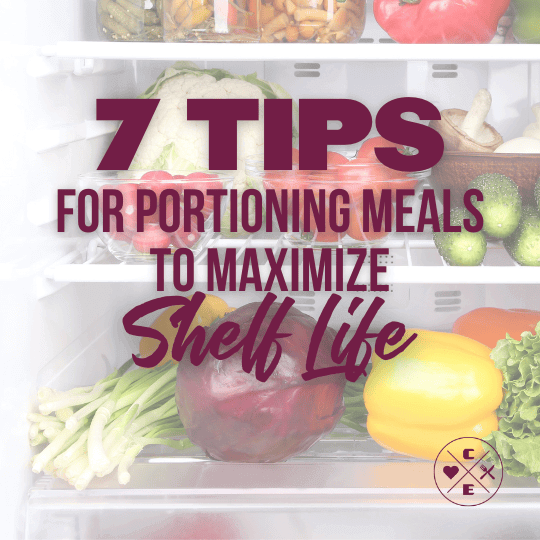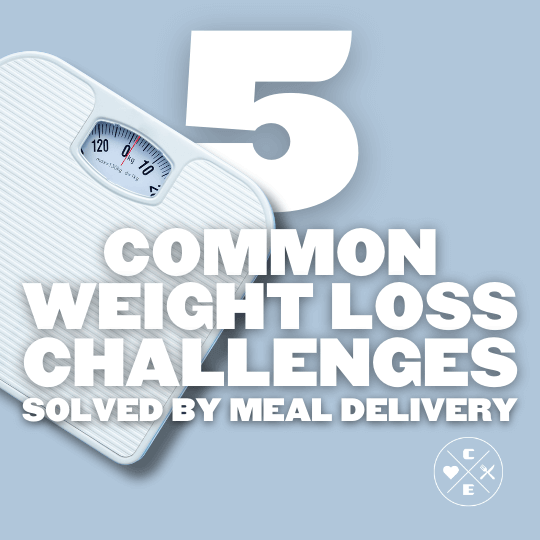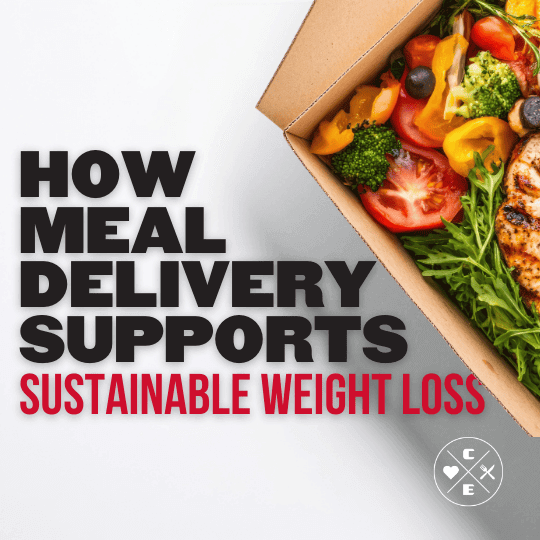
7 Tips for Portioning Meals to Maximize Shelf Life
Jason Nista
Healthy Lifestyle
12 minute read
Table of Contents
- Storing Meal Prep and Keeping it Fresh
- Tip 1: Select the Right Containers for Storage
- Tip 2: Separate Wet and Dry Ingredients
- Tip 3: Use Vacuum Sealing to Extend Shelf Life
- Tip 4: Apply the First In, First Out (FIFO) Method
- Tip 5: Portion Meals According to Serving Sizes
- Tip 6: Freeze Meals for Long-Term Storage
- Tip 7: Use Natural Preservatives
- Start Portioning Meals Wisely
- FAQs
- FAQs
Want to keep your meals fresh longer and reduce food waste? Proper portioning is the key. By using airtight containers, separating ingredients, vacuum sealing, and following smart storage techniques, you can extend the shelf life of your meals while saving money and time. Here's a quick rundown of the 7 tips covered in this guide:
- Use the Right Containers: Airtight, leakproof, and size-appropriate containers prevent spoilage.
- Separate Wet and Dry Ingredients: Avoid soggy textures by keeping components apart.
- Vacuum Seal: Remove air to preserve freshness for months or years.
- Follow FIFO (First In, First Out): Use older meals first to minimize waste.
- Portion Properly: Stick to serving sizes to avoid over-prepping.
- Freeze Meals Correctly: Store at 0°F (-18°C) to maintain quality.
- Add Natural Preservatives: Use lemon juice, vinegar, or herbs to slow spoilage.
These methods help you save food, money, and effort while keeping your meals safe and tasty. Let’s dive into the details!
Storing Meal Prep and Keeping it Fresh
Tip 1: Select the Right Containers for Storage
Choosing the proper storage containers is key to keeping food fresh and extending its shelf life. The goal is to reduce air and moisture exposure - two major culprits behind food spoilage.
Opt for Airtight and Leakproof Options
Glass and BPA-free plastic containers work well for storing food. They’re durable, resist odors, and seal tightly. For a more eco-friendly option, reusable silicone bags are great, especially for liquids like soups and sauces.
Use Containers That Fit the Portion
Picking the right container size makes a big difference. It helps prevent freezer burn and keeps food fresher for longer. Here’s a quick size guide:
| Portion Size | Suggested Container Volume |
|---|---|
| Single serving (1 cup) | 2-cup container |
| Family meal (4 cups) | 5-cup container |
| Soups/Stews (2 cups) | 3-cup container |
To avoid freezer burn, make sure to minimize air inside the container. When freezing, leave about 1/2 inch of space at the top to account for expansion [1].
Once you’ve got the right containers, the next step is organizing your ingredients to maximize freshness.
Tip 2: Separate Wet and Dry Ingredients
Keeping wet and dry ingredients apart is key to preserving food quality and avoiding spoilage. When these mix too soon, it can lead to soggy textures, faster spoilage, and unnecessary food waste.
Use Containers with Dividers
Containers with compartments, like bento boxes, work great for keeping ingredients separate. Use the largest section for dry foods like rice or grains, medium sections for semi-moist items like cooked vegetables, and the smallest ones for high-moisture foods such as fruits or tomatoes.
"Keep ingredients separated before packing them in lunches. If you want cucumbers and baby carrots, I wouldn't suggest packing them in the same container as they have two very different moisture levels." - Rachel "Smalls" Gifford [1]
Here’s a quick breakdown for organizing by moisture level:
| Compartment Type | Ideal For | Examples |
|---|---|---|
| Main Section | Dry Foods | Rice, pasta, grains |
| Medium Section | Semi-Moist Foods | Cooked veggies, proteins |
| Small Section | High-Moisture Foods | Fresh fruits, tomatoes |
Pack Sauces and Dressings Separately
Always store sauces in small, airtight containers to prevent leaks and keep textures intact. Filling these containers almost to the top minimizes air exposure.
"Storing sauces in securely closing plastic freezer bags, in the freezer, is my preferred method as it allows you to portion out smaller quantities." - Seasoned Advice Contributor [3]
For frozen meals, separating wet and dry ingredients is especially important. Ice crystals can ruin flavors and textures. If you want to take it a step further, consider vacuum sealing for even better preservation.
Tip 3: Use Vacuum Sealing to Extend Shelf Life
Vacuum sealing helps keep food fresh by removing air, which slows down oxidation and spoilage. With this method, frozen meals can stay good for up to two years, while refrigerated items can last around 10 days - much longer than traditional storage methods.
"Vacuum-sealed meat lasts longer compared to ordinary storage methods. This extended shelf life is due to the reduced oxygen environment created by vacuum sealing as air can cause food to rot sooner." - FoodSaver Team
Budget-Friendly Vacuum Sealers to Consider
For home cooks looking to save time and reduce waste, the FoodSaver Compact Vacuum Sealer and Avid Armor A420 are reliable and affordable options. To get the best results, follow these tips:
- Pre-freeze wet or juicy items before sealing.
- Leave about 7 cm of space in the bag.
- Lay food flat in the bag to make storage easier.
- Use the 'MOIST' setting for foods with high liquid content.
| Storage Method | Freezer Shelf Life | Refrigerator Shelf Life |
|---|---|---|
| Standard Storage | 3-6 months | 2-3 days |
| Vacuum Sealed | 2-3 years | Up to 10 days |
Caution: Avoid vacuum sealing raw garlic, onions, or mushrooms. These foods can develop harmful bacteria in low-oxygen environments.
Once sealed, organize your meals in the freezer or fridge so you can easily track what needs to be used first. This makes meal prepping even more efficient!
Tip 4: Apply the First In, First Out (FIFO) Method
The FIFO method helps you use older portions first, ensuring meals stay fresh and reducing waste. This approach keeps your meals at their best quality while maximizing shelf life.
Organizing and Labeling Meals
Use waterproof markers or labels to mark preparation and expiration dates on your meals. This makes it easier to track freshness and stick to proper rotation. For refrigerated meals, count the preparation day as day one and aim to eat them within seven days.
To keep things organized, arrange meals by date - older portions should go at the front or top for quick access. Use clear containers and assign specific zones for breakfast, lunch, and dinner to simplify storage. When adding new meals, place them behind or below older portions to naturally rotate stock.
For perishable items, following the FIFO method is especially important. A good storage system includes:
- Clear containers for easy visibility
- Separate zones for different meal types
- Storage bins to group similar meals together
"Labeling is a critical step in the FIFO process. Even just one person neglecting to follow FIFO will disrupt everyone's workflow and negatively affect customers' perception of the business."
Once your meals are labeled and organized, the next step is to focus on portioning them correctly to maintain freshness and avoid over-prepping.
sbb-itb-1989a25
Tip 5: Portion Meals According to Serving Sizes
Getting portions right not only keeps your meals fresh but also helps reduce waste. Sticking to standard serving sizes can prevent over-portioning and unnecessary spoilage.
Tools to Help You Portion Accurately
Using the right tools makes portioning much easier and more precise. For proteins and grains, a digital scale is your best bet. For vegetables and liquids, measuring cups and scoops are handy options.
Here’s a quick look at some useful tools:
| Tool Type | Best For | Accuracy Level |
|---|---|---|
| Digital Scale | Proteins, Grains | High (±0.1g) |
| Measuring Cups | Vegetables, Liquids | Medium |
| Portion Scoops | Rice, Pasta | Medium |
Handy Serving Size Guide
Here’s a simple guide to portioning some common ingredients:
| Food Category | Recommended Portion | Storage Duration |
|---|---|---|
| Lean Proteins | 3-4 oz (85-115g) | 3-4 days refrigerated |
| Cooked Grains | 1/2 cup (100-150g) | 5-7 days refrigerated |
| Raw Vegetables | 1 cup (50-100g) | 4-5 days refrigerated |
If you’re short on time, meal prep services like Clean Eatz Kitchen offer pre-portioned meals. These save you the effort of measuring and ensure consistent nutrition.
Pair accurate portioning with airtight containers that match your serving sizes to keep food fresh. This also helps prevent freezer burn when storing meals for longer periods [1][3].
Freezing your meals after portioning can further extend their shelf life and keep them ready for busy days.
Tip 6: Freeze Meals for Long-Term Storage
Freezing meals at 0°F (-18°C) or lower keeps them fresh for 8-12 months when packed correctly. It’s a great way to prepare meals in advance without losing quality, making meal prep and portioning much easier.
Keep Meals in Shape Before Freezing
Lay containers flat in the freezer for 2-4 hours to help them hold their shape. Once frozen, stack them neatly and label them with dates. Use airtight containers that match your portion sizes - this helps prevent freezer burn and keeps flavors intact [1][5].
Safe Thawing Methods
When it’s time to thaw, stick to these safe methods: refrigeration, a cold water bath, or the microwave’s defrost setting. Make sure to reheat meals to an internal temperature of 165°F (74°C) to ensure they’re safe to eat [2][4]. If you prefer convenience, try services like Clean Eatz Kitchen. They offer pre-portioned frozen meals that are easy to reheat and maintain their quality thanks to proper freezing techniques.
Once frozen and thawed, adding natural preservatives can help extend shelf life and maintain meal quality even further.
Tip 7: Use Natural Preservatives
Natural preservatives can boost flavor, add nutrients, and keep food fresh longer - all without relying on artificial additives. They’re a great addition to the storage and portioning methods we've already discussed, providing a simple way to maintain freshness.
Add Acidic Ingredients for Freshness
Acidic ingredients like lemon juice and vinegar create conditions that slow bacterial growth and oxidation. For example, a 1:10 vinegar-to-water solution helps berries stay fresh for up to 10 days. Similarly, coating sliced fruits like apples or avocados with lemon juice prevents browning and keeps them fresher for longer.
Here’s how natural preservatives work with vegetables:
| Ingredient | Purpose | Application Method |
|---|---|---|
| Lemon Juice | Slows oxidation | Use 2 tablespoons per quart of vegetables |
| Vinegar | Reduces bacteria | Mix in a 1:10 ratio with water for rinsing |
| Pink Sea Salt | Removes moisture | Add 1-2 teaspoons per pound of vegetables |
Use Preservative Herbs and Spices
Certain herbs and spices, like thyme and rosemary, have natural antimicrobial properties that can extend shelf life. For instance, thyme has been shown to increase the shelf life of meat products by up to 60 days. Rosemary, oregano, and turmeric are also effective, especially when used together.
Here are a couple of ways to include these natural preservatives in your meal prep:
- Add ground turmeric to rice or grain dishes.
- Sprinkle dried thyme or rosemary on proteins before storing.
Use these ingredients sparingly to maintain flavor balance and avoid overpowering your dishes. This method helps preserve food while keeping it tasty and fresh.
Start Portioning Meals Wisely
Getting meal portions right is a game-changer for keeping food fresh and cutting down on waste. By using the methods outlined here, you can keep your meals fresh longer without losing their taste or nutritional benefits. These tips not only help preserve meals but also support smarter, waste-free living.
Key tools like the right containers, ingredient separation, and vacuum sealing can make meal prep much more effective. Here's a quick look at how these methods impact shelf life:
| Storage Method | Shelf Life | Ideal For |
|---|---|---|
| Vacuum Sealed + Frozen | 2-3 months | Proteins, prepared meals |
| Airtight Container + Preservatives | 7-10 days | Fresh vegetables, grains |
| Separated Wet/Dry Components | 5-7 days | Salads, assembled meals |
Even professional meal services rely on these techniques, offering portioned, flash-frozen meals that keep their freshness and nutritional value intact.
Paying attention to the details and staying consistent will help you cut down on waste and improve the quality of your meals over time. Proper portioning isn’t just about saving food - it’s about making the most of your time, money, and health. With these methods, your meals will stay fresh, nutritious, and ready whenever you need them.
FAQs
Here are answers to some common questions about meal portioning and storage to help you get started:
How can I extend the shelf life of food?
Use airtight containers to reduce spoilage. Keep your food at the right temperatures - refrigerated items should stay at 40°F (4°C) or below, and frozen items at 0°F (-18°C). Adding ingredients like lemon juice, vinegar, or herbs can also help preserve meals naturally.
| Storage Method | Temperature |
|---|---|
| Refrigeration | 40°F (4°C) |
| Freezing | 0°F (-18°C) |
| Vacuum Sealed + Frozen | 0°F (-18°C) |
How do I keep food fresh when meal prepping?
The trick to keeping meal prep fresh lies in using the right containers and methods. Store sauces separately in leak-proof containers to avoid messes. Label your containers with preparation dates and follow the FIFO (First In, First Out) method to use older meals first [1]. Services like Clean Eatz Kitchen rely on flash-freezing and portion-controlled containers to lock in freshness.
Can meal prep be frozen to last longer?
Absolutely! Freezing is a great way to make your meal prep last. Here are some tips for freezing prepared meals:
- Use freezer-safe, airtight containers and pre-freeze items individually to avoid sticking or freezer burn.
- Remove as much air as possible from the containers.
- Clearly label each container with its contents and the date it was prepared.
- Reheat frozen meals to 165°F (74°C) before eating [2].
Freezing helps preserve meals and cut down on food waste by stopping spoilage in its tracks [3]. For the best flavor and quality, try to eat frozen meals within 2-3 months.
These tips highlight the importance of smart portioning and proper storage for keeping meals fresh and safe to eat.
Related Articles
5 Common Weight Loss Challenges Solved by Meal Delivery
9 minute read
How to Make Healthy Habits Stick Long-Term
10 minute read
How Meal Delivery Supports Sustainable Weight Loss
7 minute read



